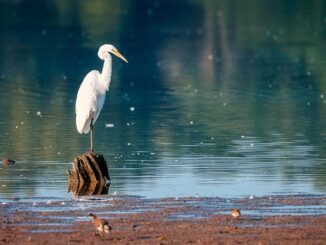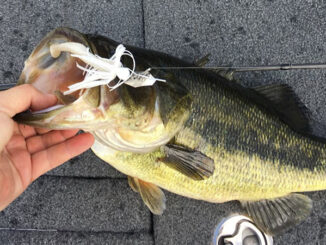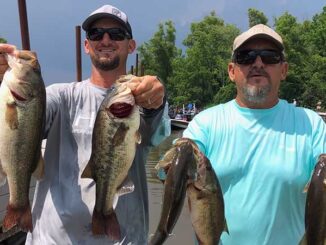
The scenic Tangipahoa River is home to a healthy population of spotted bass. But navigation can be a bit tricky — here’s how to get lucky with Kentuckys.
The grizzled veteran perched on the bow of the small flatboat expertly swung it in a half-circle in the swirling current of the Tangipahoa River.
He tossed a 2-pound spotted bass (locally most often called Kentucky bass) back into the water with a crooked grin. “If I’m eatin’ fish, I prefer a 12-incher. I like thin fish. Why kill the big ones?”
He also throws back everything 10 inches and under explaining, “I’m not pressed to keep them if I am confident of getting my limit.”
Joe Lavigne speaks with a mixture of awe and regret about his biggest spotted bass, a 4-pound, 6-ounce giant, equivalent to a 10-pound largemouth. “I didn’t register it in the record book. The guy I was with ate it.”

And he was reverential about the river. I asked why such passion.
“Look at this,” he smiled, as he waved his hand over the scenery. “No camps; no people; lots of wildlife; and that right there,” he grunted, as he set the hook on another fish.
I had to admit the view was breathtaking.
“It’s a challenge to fish the river,” he went on. “How to handle the boat in the swift current and around all the logs by simply using a sculling paddle.
“Also, you need superb casting ability. Sometimes a foot makes all the difference.”
Every cast of his seemed to be within an inch of the bank or a nook in the logs.
“The angle of the cast is important, too,” he added. “Fish want the bait coming downstream or at a right angle to the current. I’m not hardly ever going to throw the bait ahead of me and retrieve it upstream.”
A specialty seemed to be to cast so that the retrieve was made parallel and as close as possible to logs lying angled downstream. Spotted bass lying in ambush under the logs would streak out to hit the lures.
A friendly neighbor launched Lavigne in the river at a bridge, with the agreement to pick him up at the end of the float. Water color in the river was clear by most bass standards, with a milky cast.

Lavigne started the float at 10 a.m. “Float fishing is best from 10 a.m. to 3 p.m.,” he explained. “You might get argument from others, but that is what I believe. My brother Ronnie, who fishes a lot, goes at daybreak.’
From experience, he projected that the trip to the take-out point would take 5 ½ hours. Typically, floats are from highway bridge to highway bridge. The shortest float he makes is 3 ½ hours, and the longest is 6 hours. The length of the float is determined by bridge locations and water current speeds.
He caught five fish in the first quarter-mile from the bridge. “Man, they are on fire,” he said in wonderment. “They won’t bite like this all day.”
And they didn’t.
Within an hour, the bite slowed to a steady beat, with occasional flurries of fast action.
“Very seldom will you get a hard bite the whole 5 ½ hours,” he explained. “Usually I get an alternating hot and slow bite or I nickel-and-dime them all the way down — what I call a ‘working bite.’
“Like yesterday; two fish the first two hours; then 50 fish the rest of the way.”
Paddle power
Levigne worked his short sculling paddle as if it was an extension of his body. He constantly studied the river’s obstructions and likely fish-holding water and the paddle responded unconsciously to his mind.
He only laid it down to cast, retrieve or unhook a fish.
He cast with a quick side-arm motion. When the bait hit the water his right hand was already on the reel’s handles to begin motion.
While he caught the bulk of his bass on a spinner bait, he obviously loved topwater fishing. “I’d rather catch one on top than three underwater,” he mugged.
“Very seldom do they hit a spinner bait on clay banks,” his term for sharply cut banks that plunge near vertically to the water. “Topwaters and Lunker Lures are better there.”

He utterly ignored the numerous sandbars that flanked the insides of river bends.
A word about Lavigne’s float boat: The venerable battle wagon was a light-weight 12-foot aluminum flatboat sold by Sears, Roebuck and Company over 30 years ago. “A 14-foot is too heavy,” he deemed. “And a 10-footer ‘whirlybirds’ around my seat on the bow. I have more control with a 12-footer.”
He clings to the craft dearly. “They don’t make them like this anymore. This is a cheap boat. They make them out of heavier gauge aluminum now, so they are a lot heavier. It’s like having another person in the boat.
“I’ve looked everywhere to find another light one and I can’t find one. I’ve drilled the rivets out twice and replaced them using big stainless steel washers and industrial strength silicone on the rivets. I’ve also welded a couple of cracks in the floor.
“I’m always looking for another one.”
Too soon, it seemed, we neared the take-out point, Hidden Oaks Family Campground near the Highway 190 Bridge. It had been a gorgeous wilderness experience — green jungles on either side of the river, broken occasionally by glistening white sand bars.
He caught 40 bass before 1 p.m., all of them spotted except for one largemouth. They continued to bite hit-or-miss until 2 p.m., then almost quit.
“As fast as they turn on, they can turn off. You can put that in your article,” he advised.
He nailed a nice Kentucky on his Whopper Plopper right at the bridge. “Now that’s a nice way to end,” he beamed.
Tip of the day
Swapping hands holding a baitcasting rod with each cast makes absolutely no sense to Joe Lavigne. This is especially true in the chaotic conditions that make navigating a motorless boat through a riverbed full of logs and tree tops challenging, even without trying to fish.

“Learn to cast with the hand that will hold the rod during the retrieve,” he preaches. “If you are right-handed, use a left-hand reel. If you are left-handed, use a right-hand reel.”
“I want to be reeling the bait when it hits the water.”
What is it?
Spotted bass are the dominant bass species caught in the flowing waters of the Tangipahoa River, but largemouth bass occur as well. This is true for most rapidly flowing creeks and rivers in the state.
But strong populations of spotted bass occur in such different places as the swampy Atchafalaya Basin and the ocean-like Toledo Bend Reservoir. Sometimes it’s easy to tell the two species apart, but sometimes even experienced fishermen will scratch their heads when eye-balling the fish.
Sure, largemouths have larger mouths, a deeper division between their two dorsal fins, larger scales on their cheeks and they lack the rows of small dots on their bellies that their spotted cousins possess.
And taken from very clear water — on some days, spotted bass have red eyes (hence one of their nicknames, “redeyes”).
But sometimes all those indicators don’t seem to work well.
What never fails however is to stick a finger on the fish’s tongue. Largemouth bass tongues are glassy smooth. Spotted bass have an impossible-to-miss patch of vomerine teeth on the top center of the tongue that’s easy to see or feel.
When to go
“Water clarity is a big thing on when to fish the Tangipahoa River,” said Joe Lavigne emphatically.
“Rain is the big factor. Most of these banks are clay and a hard shower washes it into the river. The whole river isn’t muddy, but about 8 feet from the bank gets muddy. Once you lose that 8 feet, you lose the fish because that’s where they are.
“Because of water clarity, I figure the river is only fishable 40 percent of the year. Because it’s a dry time of the year, September, October and part of November are best. April and May can be very good, but it doesn’t happen a lot that the river is clear.
“June, July and August can be good, but not the best. I think it has something to do with water temperatures. Plus summer has a lot of thunderstorms that pop up. It takes two days to get clear again. With a big rain in Mississippi, it takes a week to clear.
“We look up north, like by McComb, Mississippi. The river can be clear and bone dry at my house in Independence, but a heavy rain in McComb will muddy the river in a day and a half.
“Another thing that affects water clarity more than you might think is road work at bridges. Lots of loose clay is exposed and will wash into the river.”
Whatever floats your boat
Since virtually all the land flanking the Tangipahoa River is privately owned, most access is made over state owned rights-of-way under highway bridges. At one time, float fishermen could leave one vehicle at the bridge where they planned to take their boat out, and then use a second vehicle to ferry the boat to a bridge upstream.

That has changed. Tangipahoa Parish, home of our current governor, has withdrawn the welcome mat. Unlike its neighboring parishes, prominent signs prohibiting parking on highway shoulders have been installed at each bridge in the parish.
“You leave a car at a bridge now; you come back and it’s towed,” frowned Joe Lavigne. “So you have to get someone to drop you and your boat off and pick it up. Cell phones are great for that. Or you can set up a time for pick-up in advance.”
According to Lavigne, the Tangipahoa River has nine separate floats, ranging from 3 ½ to 7 hours, starting near the Louisiana-Mississippi state line in the north and ending near the town of Ponchatoula. He cautioned that the times given for each float below are for expert boat handlers.
“If you get hung up on trees the whole way down, a 3 ½-hour float can turn into a 5 ½-hour float.” He also added that the further north the float is made, the clearer the water will be.
1. Highway 1055 near Greenlaw south to Highway 38 near Kentwood. Here the river is very narrow and many obstructions make it challenging to float. (5 hours.)
2. Highway 38 south to Highway 440 near Tangipahoa. This stretch of the river has no sandbars, so both banks are fishable. Its many obstructions mean lots of boat manhandling. Lavigne noted that he has taken seven or eight people on this stretch of river and each has said, “Don’t ask me to go back.” (7 hours.)
3. Highway 440 south to Highway 10 near Arcola. Here the river becomes wider and its bed holds fewer trees. He rates this stretch as relatively easy. “You probably won’t have to get out of your boat.” (5 ½ hours.)
4. Highway 10 south to Highway 16 near Amite. This stretch has many sandbars, but few places to get out of the boat. The current is very swift. “It’s like rapids,” is how he described it. “You have to really pay attention and sometimes put your rod down to control the boat.” (3 ½ hours.)
5. Highway 16 south to Highway 40 near Independence. An easy float with both numerous sand bars and deep banks. (5 hours.)
6. Highway 40 south to Highway 442 near Tickfaw. An easy float. (3 ½ hours.)
7. Highway 442 south to Highway 443 at Dunnington. Another easy float. (3 ½ hours.)
8. Highway 443 south to Highway 190 near Robert. The river becomes wider in this stretch, but maintains a significant current. (5 ½ to 6 hours.)
9. Highway 190 south to Highway 22 east of Ponchatoula. The river changes in this stretch. Its current slows down, it has fewer sandbars and it has deeper holes. But its waters take longer to clear up after rains. Bass average larger here, primarily because there are more largemouths in the catch, up to 20 percent of the total. (5 ½ hours.)


